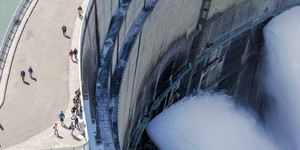Abstract
Renewable energy is the energy that is extracted from natural sources, such the Sun (solar), earth (geothermal), wind, and water (hydropower). These sources are renewable because they can be replenished by the same natural sources within a short period of time. Hydropower energy is extracted from moving water, like ocean wave energy and tidal energy. In this energy science fair project, you will make a model of a tidal barrage (also known as a dam) and investigate how emptying the tidal barrage through different-sized tunnels affects energy production.Summary
Michelle Maranowski, PhD, Science Buddies

Objective
To build a model tidal barrage or dam and to investigate how the size of the tunnel affects the speed of rotation.
Introduction
Have you ever spent the day at the beach? It's fun to lie in the Sun and build sand castles. But if you want your castle to last the day, you had better be careful where you build it. Over the course of a day, the ocean tide can come in and wipe away all the work you put into building the castle. What are ocean tides and what causes them? Tides are the periodic (occurring at regular intervals) rise and fall of the surface water level of the oceans, bays, gulfs, and inlets. The horizontal movement of the water that accompanies the changing surface is called the tidal current. The tides are periodic waves that originate in the ocean and are due to the gravitational force of the Moon, the Sun, and inertia. High tide occurs when the crest of the tidal wave hits the shore and low tide occurs when the trough of the tidal wave hits the shore. In this case, the tidal wave is defined as the rise and fall of the water surface accompanied by the tidal current. The difference in height between high tide and low tide is called the tidal range.
While the Sun is a much larger body than the Moon and exerts a larger gravitational force than the Moon, the Moon is closer to Earth and therefore, the effect of its gravitational force on the water is more significant. The gravitational force of the Moon "pulls" the water on the side of Earth facing it, toward itself. As shown in Figure 1, below, this causes a bulge in the water on the side of Earth facing the Moon. The bulge is due to the fact that gravitational force exceeds inertia. On the opposite side of Earth, inertia exceeds the gravitational force of the Moon and as a result, there is a second bulge in the water. The gravitational force of the Sun affects the size and position of the two tidal bulges. The positions of the Moon and the Sun relative to each other and to Earth affect the heights tides. For example, when the Sun, Moon, and Earth are in alignment, the tides are extra high and are called spring tides. When the Sun and the Moon are at right angles to each other, the tides are of average height and are called neap tides.
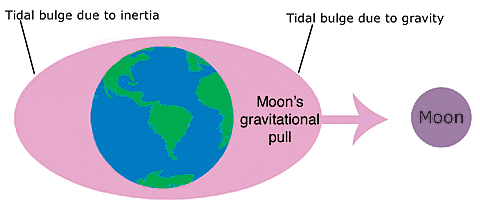 Image Credit: National Oceanic and Atmospheric Administration / Public domain.
Image Credit: National Oceanic and Atmospheric Administration / Public domain.
Figure 1. This images depicts the tidal bulges due to gravity and inertia. (Courtesy of NOAA, 2008.)
Because the motion of Earth, the Moon, and the Sun are regular and predictable, tidal motion is regular and predictable. All coastal areas experience two high tides and two low tides over a lunar day, which is 24 hours and 50 minutes long. We can take advantage of this regular motion of water to create energy. Hydropower is the power that is extracted from moving water. For instance, there are hydroelectric generators located under the Niagara Falls because there is a tremendous amount of water moving over the waterfall. The movement of the tides also produces energy, called tidal energy. Since the tides are regularly replenished, tidal energy is a type of renewable energy. For energy to be harvested from the tides, the tidal range must be at least 5 meters (m) or 16 feet. There are only about 40 places on Earth where this requirement is satisfied.
There are three types of tidal energy plants, tidal barrage (or dam), tidal fence, and tidal turbine. A tidal barrage works by forcing sea water through a turbine that is connected to a generator. Tidal fences reach across two land masses and look like turnstiles. Tidal currents make the turnstiles spin and generate electricity. The third type, tidal turbines, places turbines in rows beneath the water. As the turbines move due to the tides, they create electricity.
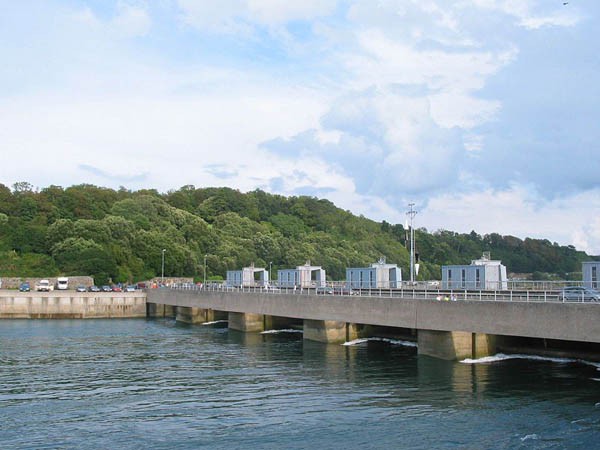 Image Credit: Wikipedia / GNU Free Documentation
Image Credit: Wikipedia / GNU Free Documentation
Figure 2. The Rance tidal barrage at Bretagne, France. (Wikipedia, 2009.)
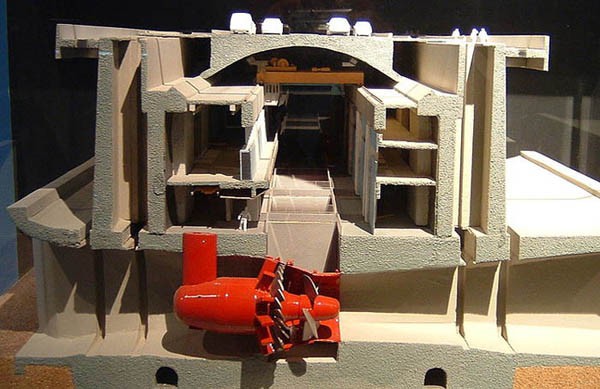 Image Credit: Wikipedia / GNU Free Documentation
Image Credit: Wikipedia / GNU Free Documentation
Figure 3. This is a model of the inner workings of the Rance tidal barrage. The turbine sits in the tunnel. On either side of the tunnel are vertical grooves for the sluice gates, which control the direction of water flow. (Wikipedia, 2009.)
There are some disadvantages to extracting energy from the tides. Building a barrage across an estuary can cause silt buildup that affects plant and sea life. Tidal barrages and tidal fences also affect sea life migration. The ecological cost of building a tidal energy plant must be weighed against the cost of creating energy from fossil fuels (a nonrenewable energy source). Building a tidal barrage also affects the tides.
In this energy science fair project, you will build a model tidal barrage to experiment with the rate of water release and see how it affects the rotation of a toy boat propeller. In a barrage, as water is forced through the turbine, it will rotate. The rotation causes the generator to create electricity. The more the turbine rotates, the more electricity is created. There are several variables that need to be considered when designing the barrage. Examples of this are the type of turbine and the size of the tunnel. For this science fair project, the propeller in your model will act as the turbine, and differently sized holes in a bucket will act as differently sized tunnels. Have fun and go with the tidal flow!
Terms and Concepts
- Tide
- Periodic event
- Gravitational force
- Inertia
- Crest
- Trough
- Tidal energy
- Renewable energy
- Tidal barrage
- Tidal fence
- Tidal turbine
- Turbine
- Flow rate
Questions
- What are tides and what causes the tides?
- What is the tidal range? What is the tidal range of the closest body of water to you?
- What is tidal energy?
- Name two locations on Earth where there are tidal energy plants.
Bibliography
- National Oceanic and Atmospheric Administration. (2008, March 25). Tides and Water Levels. Retrieved February 17, 2009.
- United States Department of Energy. (2008, December 30). Renewable Energy: Ocean Tidal Power. Retrieved February 17, 2009.
- Wikipedia Contributors. (2009, February 17). Tidal power. Wikipedia: The Free Encyclopedia. Retrieved February 17, 2009.
Visit these pages, from PG&E, a California power, gas, and electric company, for more information about electricity:
- Pacific Gas and Electric Company. (2002). Electricity Generation and Distribution. Retrieved March 4, 2009.
- Pacific Gas and Electric Company. (2002). Alternative Energy Sources. Retrieved March 4, 2009.
Materials and Equipment
- Plastic bucket, 5 gallons; available at your local hardware store
- Drill
- Drill bit, 1/2-inch
- Hole saw, 1-inch. The hole saw must fit the drill that you are using.
- Hole saw, 1 1/2-inch. The hole saw must fit the drill you are using.
- Safety goggles
- Adult volunteer to help drill and to help time the rotations
- Metal file; available at your local hardware store
- Rubber stopper, size 00; available online from stores like www.sciencekit.com, SKU # WW62855M00
- Rubber stopper, size 5.5; available online from stores like www.sciencekit.com, SKU # WW62855M55
- Rubber stopper, size 9; available online from stores like www.sciencekit.com, SKU # WW62855M09
- Model or toy boat propeller, 1 3/4-inch diameter with a 1/8-inch hole; available at your local hobby shop
- Rod, brass, 3/32-inch diameter. The rod should fit through the propeller such that the propeller moves freely on the rod. These are available at your local hobby shop.
- Dura-collars, brass-plated, 3/32-inch. Make sure that the kit comes with a matching Allen wrench and screws. These can be purchased at your local hobby shop.
- Small sticker
- Bricks (6–8)
- Plastic container, diameter should be less than the diameter of the 5-gallon bucket
- Stopwatch
- Lab notebook
- Graph paper
Experimental Procedure
- To start this science fair project, you will have to drill three holes in the bucket.
- Attach the drill bit to the drill. Whoever is drilling (you or your adult helper) should put on the safety goggles. Drill a 1/2-inch-diameter hole anywhere in the bottom of the bucket. See Figure 4, below, for an example of the completed bucket. Note: Figure 4 shows four holes, but your bucket should only have three holes.
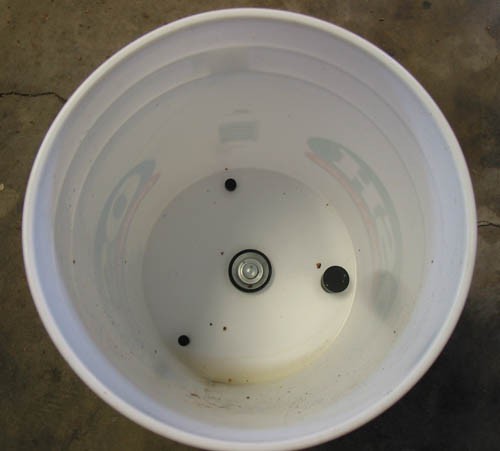 Image Credit: Michelle Maranowski, Science Buddies / Science Buddies
Image Credit: Michelle Maranowski, Science Buddies / Science Buddies
Figure 4. Completed basin and tunnels portion of the tidal barrage model. Note that this bucket has four holes, but your bucket should only have three.
- Remove the drill bit from the drill and attach the 1-inch hole saw to the drill. Drill a hole in the bottom of the bucket, a few inches away from the first hole.
- Remove the 1-inch hole saw and attach the 1 1/2-inch hole saw to the drill. Drill a hole in the bottom of the bucket a few inches away from the other two holes.
- Use the file to smooth the edges of the holes and remove any burrs. Firmly plug each of the holes with the appropriately sized rubber stopper. You have now completed the basin and tunnels portion of the tidal barrage.
- Slide the propeller onto one end of the brass rod. Slide a dura-collar onto the rod on both sides of the propeller. Use the accompanying Allen wrench and screws to tighten the dura-collars onto the brass rod. See Figure 5. Place the sticker on one of the propeller fins. The turbine portion of the model is now complete.
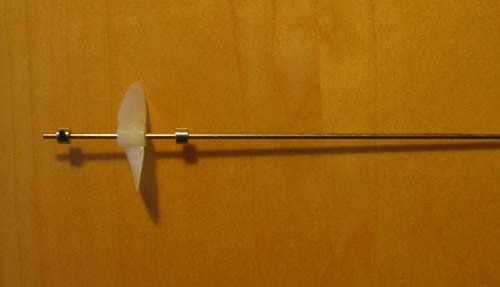 Image Credit: Michelle Maranowski, Science Buddies / Science Buddies
Image Credit: Michelle Maranowski, Science Buddies / Science Buddies
Figure 5. Completed rod and propeller assembly.
- Find a location outside where you can set up the model. Make a sturdy stand with the bricks such that you can set the bucket on top of it and have room beneath for the plastic container to catch the water.
- Place the bucket on top of the bricks and slide the container underneath. Fill the bucket half full with water.
- Hold the rod and propeller assembly vertically in the water with one hand (the propeller will be parallel to the bottom of the bucket so that it spins around like a whirl pool), directly over the 1/2-inch hole, while the other hand carefully removes the rubber stopper from the 1/2-inch hole.
- Have your volunteer time 10 seconds (sec) on the stopwatch a few seconds after you've removed the rubber stopper. During those 10 sec, count the number of rotations that the propeller makes. Use the sticker on the fin to help you count the rotations. Note the number of rotations that the propeller makes in 10 sec in your lab notebook in a data table like the one shown below. The filling and emptying of the bucket through the holes models how a tidal barrage fills at high tide and empties with low tide.
| Hole size | Trial | Rotations in 10 seconds (sec) |
| 1/2-inch | ||
- Once the water has stopped flowing, plug the hole with the rubber stopper. You can either refill the bucket with the water in the container, or use it to water plants in your yard and get fresh water for the rest of your trials.
- Repeat step 7–10 two more times with the 1/2-inch hole. Record all data in your lab notebook.
- Now repeat steps 7–12 using the 1-inch hole. Always note down all data in your lab notebook.
- Repeat steps 7–12 using the 1 1/2-inch hole. Always note down all data in your lab notebook.
- To analyze the data, plot it on a scatter plot. If you would like to learn more about plotting or would like to do your plots online, visit the following website: https://nces.ed.gov/nceskids/CreateAGraph/default.aspx. To choose scatter plot on this website, click "XY" then select "Scatter."
- Remember that the more rotations a turbine makes, the more electricity is created. Looking at your data, which hole (tunnel) creates more electricity? Did all of the holes cause the propeller to rotate?
Ask an Expert
Global Connections
The United Nations Sustainable Development Goals (UNSDGs) are a blueprint to achieve a better and more sustainable future for all.
Variations
- Choose a different-sized propeller and repeat the project. Did the size of the propeller make a difference in the number of rotations?
- Time how long it takes for the bucket to empty through each hole size. Calculate the flow rate in gallons per minute. Graph the flow rate versus the number of turns of the propeller.
Careers
If you like this project, you might enjoy exploring these related careers:






